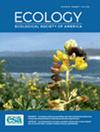Is spider resting metabolic rate more strongly associated with ecological guild or extreme habitat conditions?
IF 4.3
2区 环境科学与生态学
Q1 ECOLOGY
引用次数: 0
Abstract
Ectotherms with lower maintenance costs and broader environmental tolerances are generally more resilient in human‐altered landscapes and under current climate change, enhancing their chances of survival and colonization. In this study, we explored how habitat use and foraging strategy are associated with the resting metabolic rate (蜘蛛的静息代谢率与生态环境或极端栖息地条件的关系更密切吗?
恒温动物的维护成本较低,对环境的耐受性更强,在人类改变的景观和当前的气候变化中,它们通常更具弹性,从而提高了它们生存和定居的机会。在这项研究中,我们探讨了栖息地利用和觅食策略与蜘蛛静息代谢率(RMR)的关系,这些蜘蛛来自南大西洋森林中由于人为干扰而产生显著温度变化的栖息地:原生森林和幼松人工林。在25°C下,我们使用开流呼吸法测量了不活动蜘蛛的二氧化碳产量,以计算它们的RMR。主要发现包括:(1)所有蜘蛛的RMR比标准代谢方程预测的低22% ~ 57%;(2)在所有情况下都观察到连续的气体交换模式,这是mesic适应物种的典型特征;(3)代谢率标度指数为0.65;(4)不同生境间RMR差异不显著,但与微生境热幅呈负相关;(5)主动觅食者的rmr高于被动觅食者。这些发现增强了我们对蜘蛛生物学、生理学和生态学的理解,特别是对它们对人为压力源的反应。
本文章由计算机程序翻译,如有差异,请以英文原文为准。
求助全文
约1分钟内获得全文
求助全文
来源期刊

Ecology
环境科学-生态学
CiteScore
8.30
自引率
2.10%
发文量
332
审稿时长
3 months
期刊介绍:
Ecology publishes articles that report on the basic elements of ecological research. Emphasis is placed on concise, clear articles documenting important ecological phenomena. The journal publishes a broad array of research that includes a rapidly expanding envelope of subject matter, techniques, approaches, and concepts: paleoecology through present-day phenomena; evolutionary, population, physiological, community, and ecosystem ecology, as well as biogeochemistry; inclusive of descriptive, comparative, experimental, mathematical, statistical, and interdisciplinary approaches.
 求助内容:
求助内容: 应助结果提醒方式:
应助结果提醒方式:


